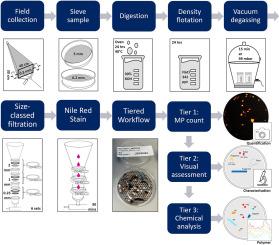An integrated, tiered microplastic workflow, supporting rapid broadscale detection options
IF 1.9
Q2 MULTIDISCIPLINARY SCIENCES
引用次数: 0
Abstract
With growing concerns regarding microplastic pollution, there is an urgent need to improve understanding of their presence, distribution, and environmental impacts. This necessitates more coordinated and harmonised large-scale microplastic monitoring initiatives. However, such assessments are traditionally expensive, labour-intensive, and hindered by a lack of standardised sampling and analytical protocols, which impede rapid, yet accurate identification of microplastic sources and ecological risks. To improve environmental microplastic contamination estimates, this study proposes a rapid, cost-effective, and bulk-processing approach within a criteria-driven Tiered Microplastics Workflow (TMW). This approach enables the efficient quantification of microplastic contamination in estuarine surface waters, offering adaptable levels of analytical resolution, that is scalable for environmental monitoring. Key features of the TMW include:
- •Streamlined processing: sieving, digestion, density separation, vacuum degassing, size-classed filtration, Nile Red staining, and automated fluorescent particle counts via a Python script, enabling 24 samples to be processed in five days.
- •Rapid Count Method: Enabling microplastic identification in broadscale monitoring within a 20 % error margin. Script-based microplastic counts align with FTIR results (R² = 0.83).
- •Flexible resolution: Sample processing can be paused and switched to other analytical methods while maintaining data comparability ensuring data harmonisation.

集成的、分层的微塑料工作流程,支持快速的大规模检测选项
随着人们对微塑料污染的日益关注,迫切需要提高对它们的存在、分布和环境影响的了解。这需要更加协调和统一的大规模微塑料监测举措。然而,这种评估传统上是昂贵的,劳动密集型的,并且受到缺乏标准化采样和分析协议的阻碍,这阻碍了对微塑料来源和生态风险的快速而准确的识别。为了提高对环境微塑料污染的估计,本研究提出了一种快速、具有成本效益的批量处理方法,该方法是标准驱动的分层微塑料工作流程(TMW)。这种方法能够有效地量化河口地表水中的微塑料污染,提供可适应的分析分辨率水平,可扩展用于环境监测。•流线型处理:筛分,消化,密度分离,真空脱气,分级过滤,尼罗河红染色,并通过Python脚本自动荧光粒子计数,使24个样品在5天内处理。•快速计数方法:在大规模监测中实现微塑料识别,误差范围在20%以内。基于脚本的微塑料计数与FTIR结果一致(R²= 0.83)。灵活的分辨率:样品处理可以暂停并切换到其他分析方法,同时保持数据可比性,确保数据协调。
本文章由计算机程序翻译,如有差异,请以英文原文为准。
求助全文
约1分钟内获得全文
求助全文
来源期刊

MethodsX
Health Professions-Medical Laboratory Technology
CiteScore
3.60
自引率
5.30%
发文量
314
审稿时长
7 weeks
期刊介绍:
 求助内容:
求助内容: 应助结果提醒方式:
应助结果提醒方式:


